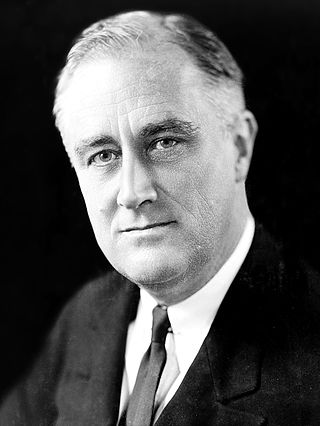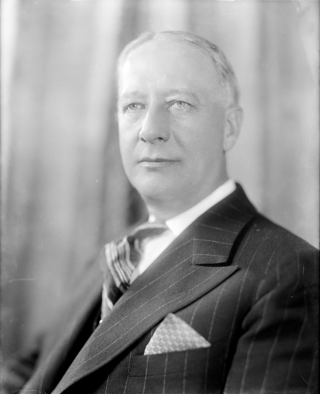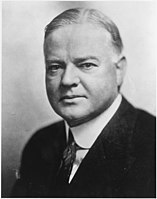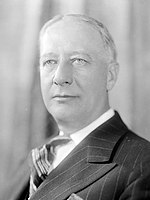
The 1932 United States presidential election was the 37th quadrennial presidential election, held on Tuesday, November 8, 1932. The election took place against the backdrop of the Great Depression. The incumbent Republican President Herbert Hoover was defeated in a landslide by Democrat Franklin D. Roosevelt, the governor of New York and the vice presidential nominee of the 1920 presidential election. Roosevelt was the first Democrat in 80 years to simultaneously win an outright majority of the electoral college and popular vote, a feat last accomplished by Franklin Pierce in 1852, as well as the first Democrat in 56 years to win a majority of the popular vote, which was last achieved by Samuel J. Tilden in 1876. Roosevelt was the last sitting governor to be elected president until Bill Clinton in 1992. Hoover became the first incumbent president to lose an election to another term since William Howard Taft in 1912, and the last to do so until Gerald Ford lost 44 years later. The election marked the effective end of the Fourth Party System, which had been dominated by Republicans. It was the first time since 1916 that a Democrat was elected president.

The 1928 United States presidential election in Vermont took place on November 6, 1928, as part of the 1928 United States presidential election which was held throughout all contemporary 48 states. Voters chose four representatives, or electors to the Electoral College, who voted for president and vice president.

The 1924 United States presidential election in Vermont took place on November 4, 1924, as part of the 1924 United States presidential election which was held throughout all contemporary 48 states. Voters chose four representatives, or electors to the Electoral College, who voted for president and vice president.

The 1928 United States presidential election in Wisconsin was held on November 6, 1928 as part of the 1928 United States presidential election. State voters chose 13 electors to the Electoral College, who voted for president and vice president.

The 1932 United States presidential election in Wisconsin was held on November 8, 1932 as part of the 1932 United States presidential election. State voters chose 12 electors to the Electoral College, who voted for president and vice president.

The 1928 United States presidential election in Washington took place on November 6, 1928 as part of the 1928 United States presidential election. Washington's voters selected seven voters to the Electoral College, who voted for president and vice president.

The 1928 United States presidential election in Connecticut took place on November 6, 1928, as part of the 1928 United States presidential election which was held throughout all contemporary 48 states. Voters chose seven representatives, or electors to the Electoral College, who voted for president and vice president.

Al Smith, Governor of New York, was a candidate for President of the United States in the 1928 election. His run was notable in that he was the first Catholic nominee of a major party, he opposed Prohibition, and he enjoyed broad appeal among women, who had won the right of suffrage in 1920.

The 1928 United States presidential election in Wyoming took place on November 6, 1928, as part of the 1928 United States presidential election. State voters chose three representatives, or electors, to the Electoral College, who voted for president and vice president.

The 1928 United States presidential election in Ohio was held on November 6, 1928, as part of the 1928 United States presidential election. State voters chose 24 electors to the Electoral College, who voted for president and vice president.

The 1928 United States presidential election in Texas took place on November 6, 1928, as part of the 1928 United States presidential election which was held throughout all contemporary forty-eight states. Voters chose 20 representatives, or electors, to the Electoral College, who voted for president and vice president.

The 1928 United States presidential election in Michigan took place on November 6, 1928, as part of the 1928 United States presidential election. Voters chose 15 representatives, or electors, to the Electoral College, who voted for president and vice president.

The 1928 United States presidential election in Kansas took place on November 6, 1928, as part of the 1928 United States presidential election which was held throughout all contemporary 48 states. Voters chose ten representatives, or electors to the Electoral College, who voted for president and vice president.

The 1932 United States presidential election in North Dakota took place on November 8, 1932, as part of the 1932 United States presidential election. Voters chose four representatives, or electors, to the Electoral College, who voted for president and vice president.

The 1928 United States presidential election in South Dakota took place on November 6, 1928, as part of the 1928 United States presidential election which was held throughout all contemporary 48 states. Voters chose five representatives, or electors to the Electoral College, who voted for president and vice president.

The 1928 United States presidential election in North Dakota took place on November 6, 1928, as part of the 1928 United States presidential election which was held throughout all contemporary 48 states. Voters chose five representatives, or electors to the Electoral College, who voted for president and vice president.

The 1928 United States presidential election in Oregon took place on November 6, 1928, as part of the 1928 United States presidential election. Voters chose five representatives, or electors, to the Electoral College, who voted for president and vice president.

The 1928 United States presidential election in Oklahoma took place on November 6, 1928, as part of the 1928 United States presidential election which was held throughout all contemporary 48 states. Voters chose ten representatives, or electors to the Electoral College, who voted for president and vice president. In its early years, Oklahoma was a “Solid South” state whose founding fathers like "Alfalfa Bill" Murray and Charles N. Haskell had disfranchised most of its black population via literacy tests and grandfather clauses, the latter of which would be declared unconstitutional in Guinn v. United States. In 1920 this “Solid South” state, nonetheless, joined the Republican landslide of Warren G. Harding, electing a GOP senator and five congressmen, but in 1922 the Democratic Party returned to their typical ascendancy as the state GOP became heatedly divided amongst themselves.

Republican candidate Herbert Hoover won the state of Illinois in the 1928 United States presidential election, and would emerge victorious from the overall election. State voters chose 29 representatives, or electors, to the Electoral College, who voted for president and vice president.

The 1928 United States presidential election in Mississippi took place on November 6, 1928, as part of the wider United States presidential election. Voters chose 10 representatives, or electors, to the Electoral College, who voted for president and vice president.
























